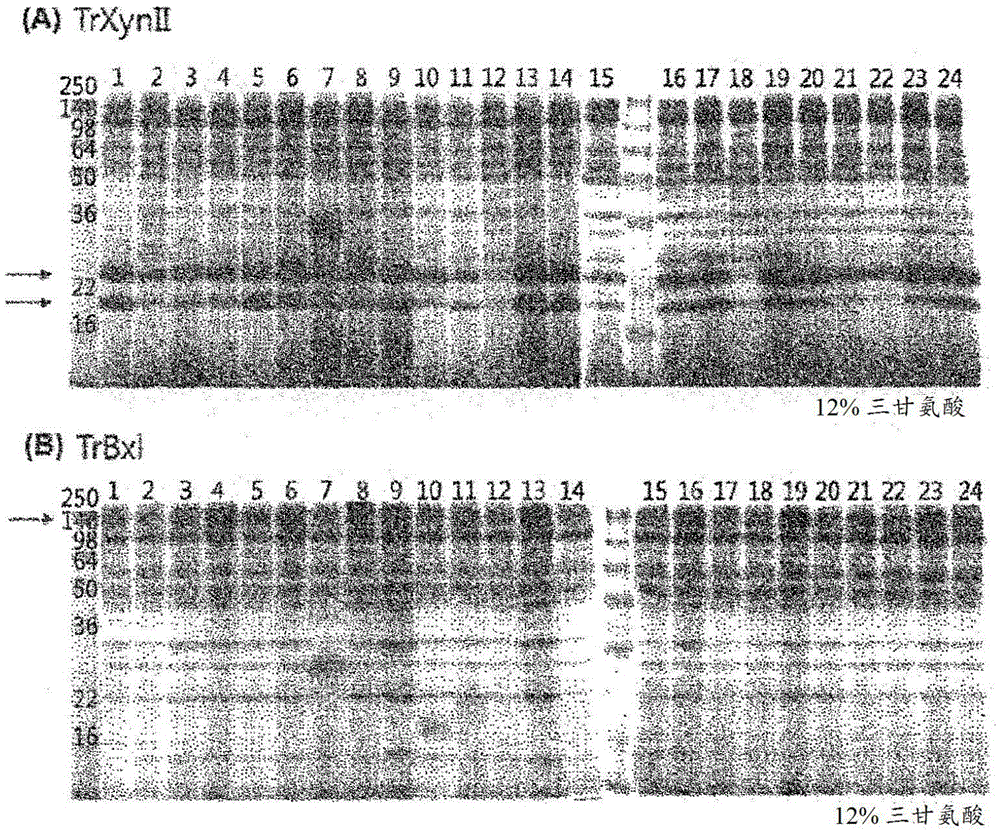Recombinant cellulose diastatic enzyme cocktail, recombinant yeast complex strain, and use thereof
A yeast and transformant technology, applied in the field of expression cassettes containing the expression cassettes, can solve the problems of limited bioethanol production, low ethanol production efficiency, and inability to effectively decompose cellulose substrates
- Summary
- Abstract
- Description
- Claims
- Application Information
AI Technical Summary
Problems solved by technology
Method used
Image
Examples
Embodiment 1
[0087] Embodiment 1: use bacterial strain and experimental material
[0088] Ensuring yeast-based hemicellulase, endoglucanase, exoglucanase and β-glucanase glucosidase gene
[0089]In order to effectively utilize endo-xylanase (endo-xylanase) TrXynII (sequence numbers 1, 2) and β-xylosidase (beta-xylosidase) TrBxl (sequence numbers 3, 4) derived from Trichoderma reesei ) and endo-glucanase (endo-glucanase) TrEGL2 (sequence numbers 5, 6) genes, using the nucleotide sequence information of the National Center for Biotechnology Information (NCBI). Regarding Trichoderma reesei, the strain (KCTC6968) distributed by the Bioresource Center was cultured in a potato dextrose agar medium (PotatoDextroseAgar, Difco) at 25°C for 5 days, and after only the mold mycelium that had completed the culture was filtered and recovered, The T.H. Al-Samarrai mold genomic DNA extraction method was used (T.H. Al-Sammarrai et al., 2000, Letters in Applied Microbiology, 30, 53-56).
[0090] In ...
Embodiment 2
[0101] Example 2: Hemicellulase by introduction of a translational fusion partner (TFP), Secreted production of endoglucanase and exoglucanase
[0102] In order to express the two hemicellulase, one endoglucanase and seven exoglucanase genes ensured by Example 1 in the Saccharomyces cerevisiae strain, primer LNK39 (SEQ ID NO: 45) was used from each gene After amplification with GT50R (SEQ ID NO. 46), 24 protein secretion fusion partners (Korean Patent No. 10-0975596, TFP1 to TFP24) vectors that assist protein secretion expression were introduced into Y2805 (Matapep4:: HIS3prb1can1his3-200ura3-52) strain. The sequences of TFP1 to TFP24 are shown in Table 3 below.
[0103] [table 3]
[0104]
[0105]
[0106]
[0107] Since the polymerase chain reaction product amplified by LNK39 (SEQ ID NO: 45) and GT50R (SEQ ID NO: 46) primers contains the same sequence as the vector above 40base, if it is introduced into yeast cells together with the linearized vector, the Cro...
Embodiment 3
[0109] Example 3: Hemicellulase, endogenous Activity Confirmation of Exoglucanase and Exoglucan
[0110] In order to confirm the activity of the protein secreted from each transformant, the activity analysis method for each protein as described below was used.
[0111] 3-1. Confirmation of endoxylanase activity of secreted TrXynII protein
[0112]To confirm the activity of the secreted TrXynII protein, the DNS (dinitirosalicylic acid, dinitrosalicylic acid) quantification method (Miller, G.L., Anal. Chem, 55:952-959, 1959) was used. Add 100 μl matrix solution (100 mM potassium phosphate solution containing 1% oat xylan (optspeltxylan), pH 5.0) to 100 μl enzyme solution, react at 60° C. for 30 minutes, add 700 μl DNS (3,5-Dinitrosalicylicacid, 3 , 5-dinitrosalicylic acid) solution, and treated at 100°C for 5 minutes, and then measured at absorbance at 540 nm after cooling with cold water. As a result of analyzing the activity of endoxylanase (Table 4), the activity of T...
PUM
 Login to View More
Login to View More Abstract
Description
Claims
Application Information
 Login to View More
Login to View More - R&D Engineer
- R&D Manager
- IP Professional
- Industry Leading Data Capabilities
- Powerful AI technology
- Patent DNA Extraction
Browse by: Latest US Patents, China's latest patents, Technical Efficacy Thesaurus, Application Domain, Technology Topic, Popular Technical Reports.
© 2024 PatSnap. All rights reserved.Legal|Privacy policy|Modern Slavery Act Transparency Statement|Sitemap|About US| Contact US: help@patsnap.com










